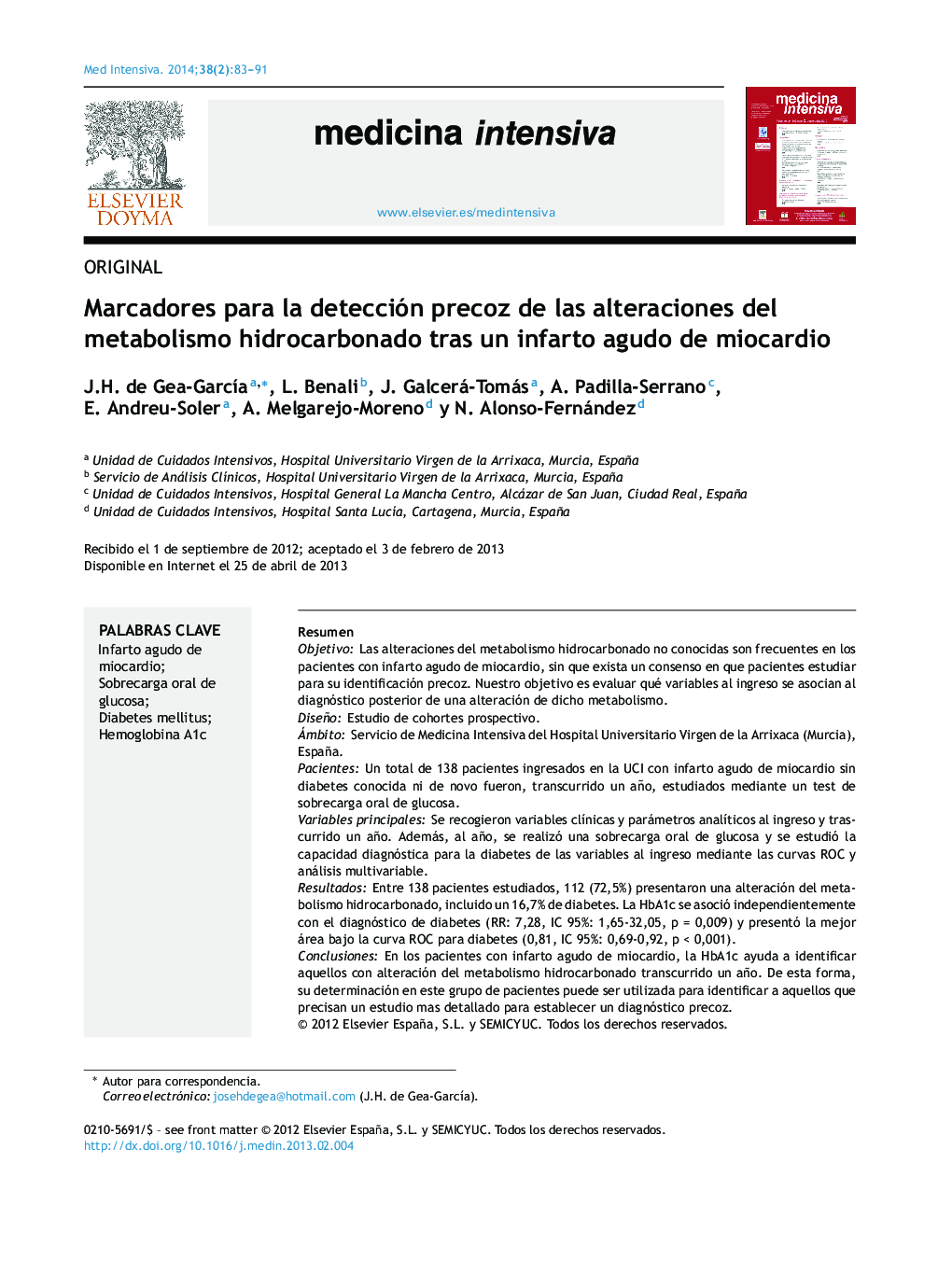| کد مقاله | کد نشریه | سال انتشار | مقاله انگلیسی | نسخه تمام متن |
|---|---|---|---|---|
| 3112767 | 1192335 | 2014 | 9 صفحه PDF | دانلود رایگان |
ResumenObjetivoLas alteraciones del metabolismo hidrocarbonado no conocidas son frecuentes en los pacientes con infarto agudo de miocardio, sin que exista un consenso en que pacientes estudiar para su identificación precoz. Nuestro objetivo es evaluar qué variables al ingreso se asocian al diagnóstico posterior de una alteración de dicho metabolismo.DiseñoEstudio de cohortes prospectivo.ÁmbitoServicio de Medicina Intensiva del Hospital Universitario Virgen de la Arrixaca (Murcia), España.PacientesUn total de 138 pacientes ingresados en la UCI con infarto agudo de miocardio sin diabetes conocida ni de novo fueron, transcurrido un año, estudiados mediante un test de sobrecarga oral de glucosa.Variables principalesSe recogieron variables clínicas y parámetros analíticos al ingreso y trascurrido un año. Además, al año, se realizó una sobrecarga oral de glucosa y se estudió la capacidad diagnóstica para la diabetes de las variables al ingreso mediante las curvas ROC y análisis multivariable.ResultadosEntre 138 pacientes estudiados, 112 (72,5%) presentaron una alteración del metabolismo hidrocarbonado, incluido un 16,7% de diabetes. La HbA1c se asoció independientemente con el diagnóstico de diabetes (RR: 7,28, IC 95%: 1,65-32,05, p = 0,009) y presentó la mejor área bajo la curva ROC para diabetes (0,81, IC 95%: 0,69-0,92, p < 0,001).ConclusionesEn los pacientes con infarto agudo de miocardio, la HbA1c ayuda a identificar aquellos con alteración del metabolismo hidrocarbonado transcurrido un año. De esta forma, su determinación en este grupo de pacientes puede ser utilizada para identificar a aquellos que precisan un estudio mas detallado para establecer un diagnóstico precoz.
ObjectivesUndiagnosed abnormal glucose metabolism is often seen in patients admitted with acute myocardial infarction, although there is no consensus on which patients should be studied with a view to establishing an early diagnosis. The present study examines the potential of certain variables obtained upon admission to diagnose abnormal glucose metabolism.DesignA prospective cohort study was carried out.SettingThe Intensive Care Unit of Arrixaca University Hospital (Murcia), Spain.PatientsA total of 138 patients admitted to the Intensive Care Unit with acute myocardial infarction and without known or de novo diabetes mellitus. After one year, oral glucose tolerance testing was performed.Main outcomesClinical and laboratory test parameters were recorded upon admission and one year after discharge. Additionally, after one year, oral glucose tolerance tests were made, and a study was made of the capacity of the variables obtained at admission to diagnose diabetes, based on the ROC curves and multivariate analysis.ResultsOf the 138 patients, 112 (72.5%) had glucose metabolic alteration, including 16.7% with diabetes. HbA1c was independently associated with a diagnosis of diabetes (RR: 7.28, 95%CI 1.65 to 32.05, P = .009), and showed the largest area under the ROC curve for diabetes (0.81, 95%CI 0.69 to 0.92, P = .001).ConclusionsIn patients with acute myocardial infarction, HbA1c helps identify those individuals with abnormal glucose metabolism after one year. Thus, its determination in this group of patients could be used to identify those subjects requiring a more exhaustive study in order to establish an early diagnosis.
Journal: Medicina Intensiva - Volume 38, Issue 2, March 2014, Pages 83–91
